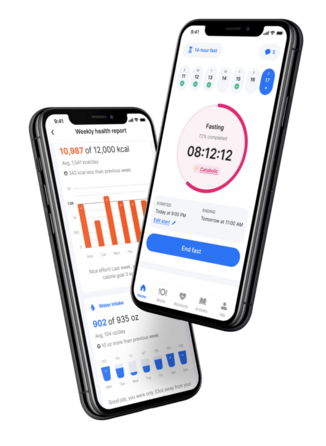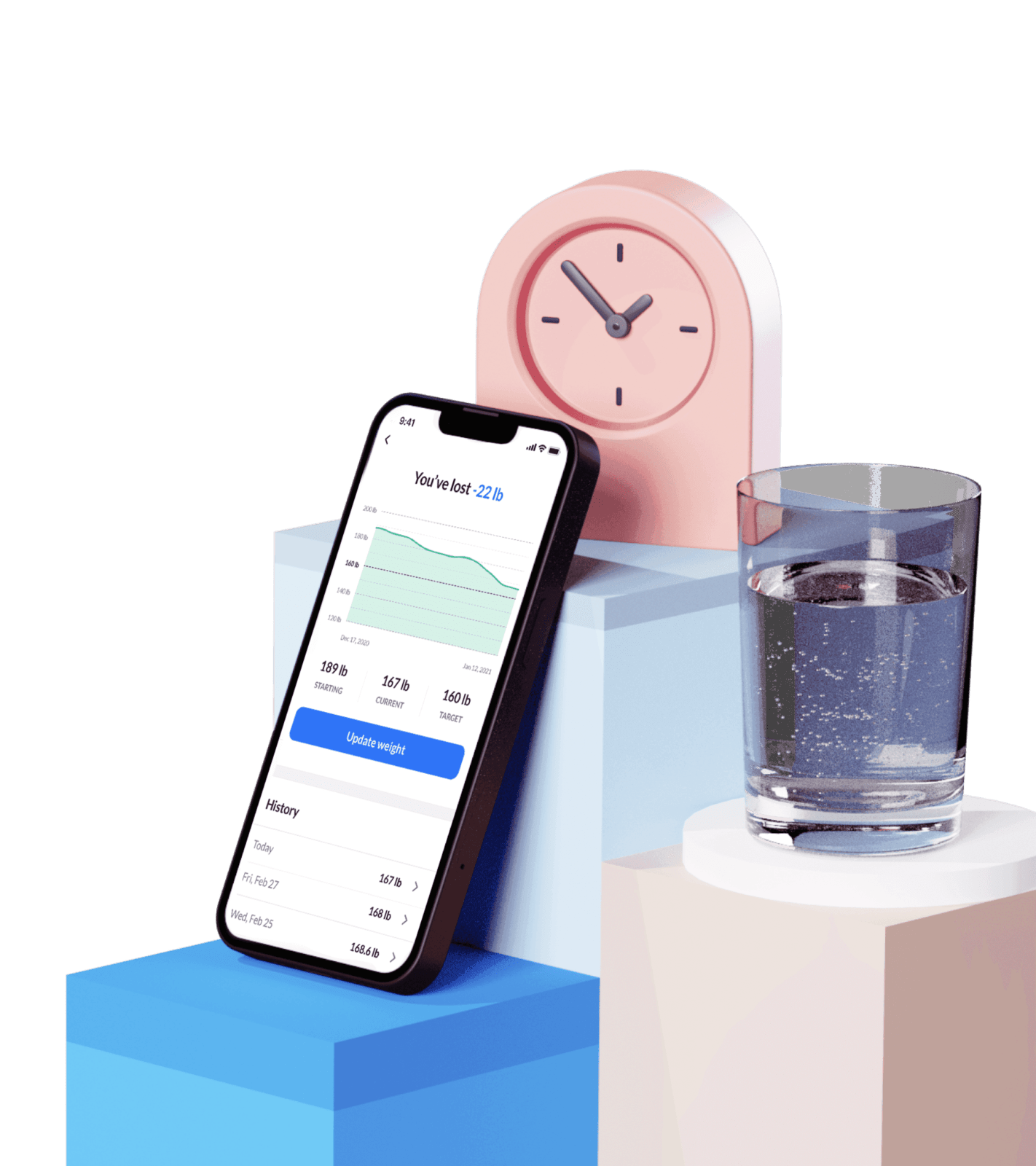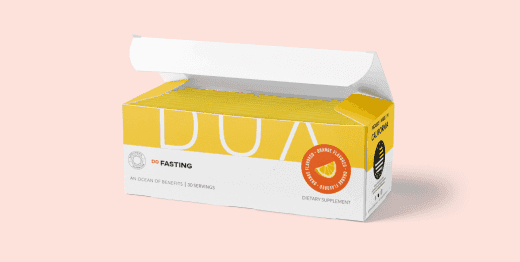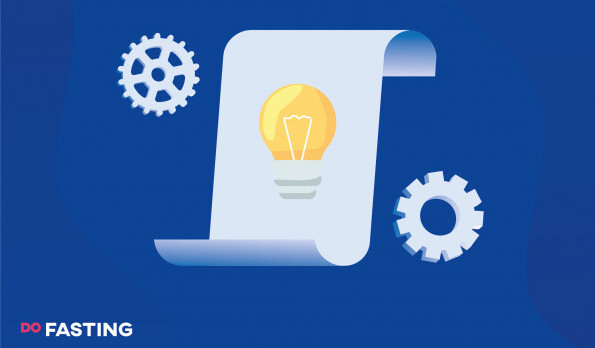Contents
1. Consider Your Fasting Type
There are lots of types of intermittent fasting. Some of them are better for beginners, and some of them are aimed at experts. The type you choose could also depend on the goal you’re seeking to achieve.
Therefore, it’s important to choose the one that meets your unique needs. Especially if you’re new to the concept.
In this part of the article, we’ll go through short-term and long-term fasting and how they differ from one another.
Take a
1-minute quiz
and discover how much weight you can lose with DoFasting!

What is short-term fasting?
The simplest way to describe a short-term fast is the time from when you go to bed to when you have your breakfast the next morning. This is the easiest way to go through a 12 to 18-hour fasting period.
As a newbie, you might want to start with short-term fasting and work your way up to a long-term one.
Short-term fasting types:
- 12-hour fast – features a 12-hour eating window and a 12-hour fasting window. Most of the fasting window is spent during sleeping hours.
- 14-hour fast – features a 10-hour eating window and a 14-hour fasting window. Because the 7-hour fast occurs while you sleep and there are only 7 hours remaining to fast, it’s considerably simpler to complete.
- 16-hour fast – features an 8-hour eating window and a 16-hour fasting window. Your body enters a prolonged state of ketosis, which means your metabolism begins to burn fat rather than blood sugar reserves.
- 18-hour fast – features a 6-hour eating window and an 18-hour fasting window. This type of fast helps you reduce your food intake, burn fat, and reduce insulin levels.
What is long-term fasting?
Long-term fasting is an extended fast recommended for experienced fasters. Long fasts increase fat burning because the body relies entirely on its own fat stores rather than dietary fat intake.
Long-term fasting types:
- 20-hour fast (the Warrior Diet) – features a 4-hour eating window and a 20-hour fasting window. The concept is to eat relatively little during the day and then “feast” in the evening.
- 24-hour fast – the abstinence from eating for 24 hours at a time. This method can be done once a month, once a week, or even more frequently. It’s best for effectively losing weight.
- 36-hour fast – the abstinence from eating for 36 hours at a time. It’s an advanced method of intermittent fasting that lowers blood sugar levels.
The difference between short-term and long-term fasting
Long-term fasting entails a more serious form of calorie restriction than short-term fasting. As I’ve mentioned above, long-term fasting can go from 20 hours to 36 hours and even more. It depends on what you choose.
However, long-term fasts require longer breaks. This means that you can fast once a week, once a month, or once every six months. You can attempt short-term fasting every other day.
Besides, you can’t break a long-term fast too quickly. It can result in nausea, diarrhea, or dizziness. General tips for ending a short-term fast:
- Eat gentler foods – there are certain foods that are best as a first meal, such as nourishing soups.
- Be mindful – don’t resort to cheat meals right away.
- Don’t overeat – you could feel worse afterward.
- Eat slowly – this will help your digestive system.
General tips for ending a long-term fast:
- Choose the right foods – restrain from high-carb foods.
- Eat in small portions – don’t overwork your digestive system.
- Drink lots of water – helps your body adjust and replenish electrolytes.
Keeping these tips in mind, there are foods that will break your fast as well as foods that will allow you to extend your fast. The trick is to know exactly what to consume.
2. Know What Breaks a Fast
The number of calories consumed to meet the body’s energy requirements will break a fast. Certain meals and drinks, on the other hand, will not break your fast and may even make it easier. This is especially beneficial if you’re attempting to transition into a longer fasting window.
DoFasting is an intermittent fasting app that offers expert tools and education to ease your fasting journey. The app has various features, such as a step, water, and calorie tracker. It also includes a fasting timer.
Moreover, you’ll be able to see your progress and get weekly updates and suggestions on your weight loss journey.
People who utilize the DoFasting app have no trouble finding the correct fast-breakers. This is due to the app’s inclusion of many articles that explain everything about fasting, as well as dietary recommendations provided by specialists.
A way to extend a fast with food
Here is a list of foods, vitamins, and beverages that you can consume to make prolonged fasting easier:
- Coconut oil – doesn’t cause an insulin response. It won’t break ketosis.
- Bone broth – the nutrients can help restore electrolytes lost over prolonged durations of merely drinking water.
- DoFasting’s Essential Fiber Complex – an appetite suppressant that includes glucomannan and cellulose. The ingredients tell our brains to quit craving food and instead focus on fat-burning.
- Apple Cider Vinegar Gummies – includes your daily dose of vitamins, reduce sugar cravings, and boost your metabolism.
- Tea – herbal teas such as green tea can decrease appetite.
- Black coffee – caffeine can act as an appetite suppressant.
- Water with electrolytes – contains zero calories.
- Apple cider vinegar – decreases appetite, and has anti-inflammatory and anti-bacterial compounds.
Now that we’ve established what doesn’t break a fast, we can move on to picking the right meals for breaking a fast.
Take a
1-minute quiz
and discover how much weight you can lose with DoFasting!

3. Choose the Right Foods and Know What to Avoid
When breaking a fast, especially a long-term fast, you need to avoid carb-loaded meals and sugary beverages. Moreover, you should also choose easily digestible foods.
This way you will avoid uncomfortable side effects and take the most out of your intermittent fasting routine.
In this section of the article, we’ll go over exactly what to eat and what not to eat when breaking a fast.
What to eat when breaking a fast
Here are the best foods to break the intermittent fasting window:
- Bone broth – is a good source of nutrients that also aids in the restoration of electrolytes.
- Soups – those that include lentils, pasta, tofu, or other easily digestible carbs.
- Easy-to-digest proteins – fish, which is a great source of protein also provides Omega-3 fatty acids, calcium, potassium, niacin, selenium, and B-and D-vitamins.
- Cooked vegetables – fiber, minerals, and vitamins are abundant in non-starchy vegetables such as broccoli, cauliflower, and brussels sprouts.
- Avocado and avocado oil – easily digestible and can prevent overeating after fasting. It’s rich in water-soluble fiber and fats.
- Extra virgin olive oil, and grass-fed butter – include plenty of healthy fats. Olive oil has anti-inflammatory effects.
- Smoothies – you can put yogurt, kefir, and some leafy greens and have a perfectly healthy meal with micronutrients.
As there are foods that you want to eat when breaking a fast, there are foods that you should avoid as well.
What not to eat when breaking a fast
Here is a list of what not to eat when breaking a fast:
- Raw cruciferous vegetables – include raffinose, a sugar that remains undigested until bacteria in your stomach ferment it, causing gas and bloating.
- Red meat – is difficult to digest.
- High-fat dairy products – people tend to be more sensitive to lactose which can cause side effects.
- Seeds and seed butter – are difficult to digest.
Also, eat light meals and arrange larger meals for later throughout your fasting window.
4. Alcohol Is Never a Good Idea
One drink of alcohol might add 100 calories or more to your regular calorie consumption. Therefore, if you are fasting or just trying to lose weight – alcohol is never a good idea.
In other words, alcohol can promote weight gain.
Additionally, while intermittent fasting decreases inflammation in the body, alcohol can cause inflammation. As a result, it may work against the benefits of intermittent fasting. Excessive drinking can also lead to an imbalance in gut bacteria.
Alcohol overwhelms the liver, which can decrease its ability to filter out potentially harmful toxins.
Avoiding alcohol is especially important after a long-term fast. When you drink alcohol on an empty stomach, the alcohol gets absorbed into your bloodstream. This is because it swiftly travels from your stomach into your small intestine.
Heavy alcohol intake can cause alcoholic ketoacidosis. It’s a condition in which ketones are extremely high in the blood, but blood glucose is dangerously low.
Even without drinking alcohol, resuming food consumption can bring possible side effects.
5. Prepare Yourself for the Possible Side Effects
After you resume eating, you may experience certain side effects. This might happen if you’ve tried an extended fast or if you’re new to fasting. As a result, it’s important to be prepared and know what to expect.
Short-term fasts rarely have side effects. Long-term fasts, on the other hand, can have these side effects:
- Electrolyte imbalance
- Fatigue
- Low-energy
- Diarrhea
- Bloating
- Nausea and vomiting
This is because after you start eating again, you might have gastrointestinal discomfort since your body can shut down its production of digestive enzymes. Digestive enzymes are proteins that accelerate chemical processes that transform nutrients into compounds that can be absorbed by your digestive tract.
If you do experience a lot of these side effects, you should shorten your fast until you get more used to it. Moreover, make sure to break your fasting window with the best foods, and drink enough water.
The possible side effects of a short-term fast:
- Headache
- Feeling tired
To mitigate these side effects, drink a lot of water, avoid problematic foods, and include daily movement.
6. Hydration and Replenishing Electrolytes Are Key
Fasting causes the body to lose water and electrolytes by depleting carbohydrate reserves. This is why, for example, bone broth could be the greatest food to break a fast.
Moreover, it’s important to drink plenty of water overall. Water is required to maintain the structure of our cells, regulate our body temperature, maintain our blood volume, aid in body metabolism, assist in all digestion and absorption functions, to lubricate mucous membranes in the gastrointestinal and respiratory tracts.
An average person needs to drink 8-15 glasses of water a day.
As much as it’s important to hydrate and replenish electrolytes at the end of your fast, it’s also important to your progress. Drinking water can help manage hunger pangs and prevent you from breaking your fast earlier than intended.
It can also make you feel less exhausted and irritable when fasting, increasing your chances of sticking to your plan and controlling your weight loss journey.
Some people, however, forget to drink water during the day or are unsure of how much they should drink altogether. This is where some additional tools might come in handy.
Take a
1-minute quiz
and discover how much weight you can lose with DoFasting!

How to Break a Fast: Key Takeaways
To properly break a fast and minimize any side effects, use easily digestible meals such as bone broth and cooked veggies. Also, remember the significance of staying hydrated and avoiding alcohol at all costs.
See how DoFasting will improve your life
Find out what works for you with this 60-sec quiz approved by our experts and get your personal revolutionary fasting assistant.
Start the Quiz
This is an evidence-based article that includes scientific citations. DoFasting’s professional writers and editors prepared the content, which a team of medical experts verified to be accurate.















